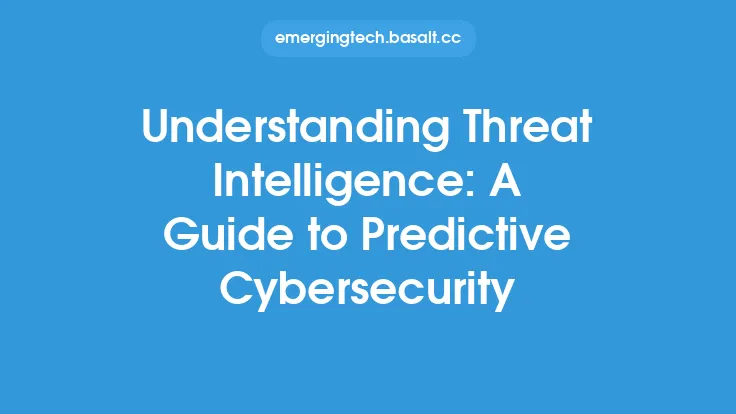In today's digital age, cybersecurity is a critical aspect of our personal and professional lives. As technology advances and more aspects of our lives become connected to the internet, the risk of cyber threats and attacks increases. To protect ourselves and our organizations from these threats, it's essential to have a solid understanding of cybersecurity basics. This includes key concepts, terminology, and best practices that can help prevent cyber attacks and ensure the security of our digital assets.
Introduction to Cybersecurity
Cybersecurity refers to the practices, technologies, and processes designed to protect digital information, networks, and systems from unauthorized access, use, disclosure, disruption, modification, or destruction. This includes a range of measures, from firewalls and antivirus software to encryption and secure coding practices. The goal of cybersecurity is to ensure the confidentiality, integrity, and availability of digital information, as well as the security of the systems and networks that store and transmit this information.
Key Cybersecurity Concepts
There are several key concepts that are fundamental to understanding cybersecurity. These include:
- Confidentiality: The principle of ensuring that sensitive information is only accessible to authorized individuals or systems.
- Integrity: The principle of ensuring that digital information is accurate, complete, and not modified without authorization.
- Availability: The principle of ensuring that digital information and systems are accessible and usable when needed.
- Authentication: The process of verifying the identity of users, systems, or devices.
- Authorization: The process of granting or denying access to digital information or systems based on a user's identity or role.
- Encryption: The process of converting plaintext data into unreadable ciphertext to protect it from unauthorized access.
- Firewalls: Network security systems that monitor and control incoming and outgoing network traffic based on predetermined security rules.
Cybersecurity Threats and Vulnerabilities
Cybersecurity threats and vulnerabilities are potential weaknesses or exploits that can be used by attackers to compromise digital information or systems. These include:
- Malware: Software designed to harm or exploit a computer system, such as viruses, worms, and trojans.
- Phishing: A type of social engineering attack that uses email or other communication channels to trick users into revealing sensitive information.
- SQL injection: A type of attack that involves injecting malicious code into a database to extract or modify sensitive data.
- Cross-site scripting (XSS): A type of attack that involves injecting malicious code into a website to steal user data or take control of the user's session.
- Denial of service (DoS): A type of attack that involves overwhelming a system or network with traffic in order to make it unavailable to users.
- Zero-day exploits: Vulnerabilities in software or hardware that are unknown to the vendor or have not been patched, making them vulnerable to attack.
Cybersecurity Controls and Countermeasures
To protect against cybersecurity threats and vulnerabilities, a range of controls and countermeasures can be implemented. These include:
- Firewalls: Network security systems that monitor and control incoming and outgoing network traffic based on predetermined security rules.
- Intrusion detection and prevention systems (IDPS): Systems that monitor network traffic for signs of unauthorized access or malicious activity.
- Encryption: The process of converting plaintext data into unreadable ciphertext to protect it from unauthorized access.
- Access control: The process of granting or denying access to digital information or systems based on a user's identity or role.
- Secure coding practices: The use of secure coding techniques and best practices to prevent vulnerabilities in software and applications.
- Regular software updates and patches: The process of regularly updating and patching software and systems to fix vulnerabilities and prevent exploitation.
Cybersecurity Frameworks and Standards
To help organizations implement effective cybersecurity controls and countermeasures, a range of frameworks and standards have been developed. These include:
- NIST Cybersecurity Framework: A framework that provides a structured approach to managing and reducing cybersecurity risk.
- ISO 27001: A standard that provides a framework for implementing and maintaining an information security management system (ISMS).
- PCI-DSS: A standard that provides a framework for securing credit card data and preventing fraud.
- HIPAA: A standard that provides a framework for securing protected health information (PHI) and preventing unauthorized disclosure.
Conclusion
In conclusion, cybersecurity is a critical aspect of our personal and professional lives, and understanding the key concepts, terminology, and best practices is essential for protecting ourselves and our organizations from cyber threats and attacks. By implementing effective cybersecurity controls and countermeasures, and following established frameworks and standards, we can help ensure the security and integrity of our digital assets and prevent cyber attacks. Whether you're an individual or an organization, it's essential to stay informed and up-to-date on the latest cybersecurity threats and best practices to stay safe online.





